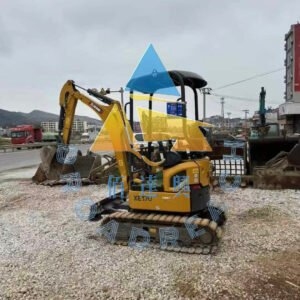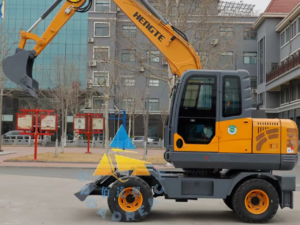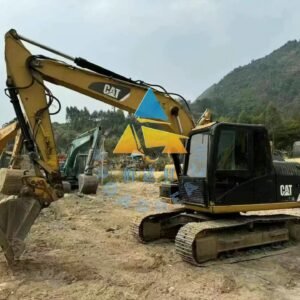BroadReach Construction Machinery S.L.

Descripción de los implementos para excavadoras: Guía de los distintos implementos y sus aplicaciones
Excavators are among the most versatile and essential pieces of equipment in construction, demolition, and many other industries. While the excavator itself is a powerful machine, it’s the various attachments that truly expand its functionality, making it capable of handling a wide range of tasks—from digging and lifting to breaking concrete or even performing precise grading work. Understanding the different types of excavator attachments and how to choose the right one for your project can significantly improve efficiency and productivity.
Types of Excavator Attachments
Excavator attachments come in various shapes and sizes, each designed for a specific purpose. Here’s an overview of some of the most common attachments and their applications:
1. Buckets
Application: Digging, scooping, and moving materials
Types: Standard bucket, heavy-duty bucket, rock bucket, trenching bucket, grading bucket
Descripción: Buckets are the most common excavator attachment and are used for a variety of tasks, such as digging trenches, lifting soil or debris, and clearing material. Different bucket types are suited to different materials and tasks—rock buckets, for example, have reinforced teeth for digging through tough materials like rock, while grading buckets are ideal for leveling and shaping earth.
2. Hydraulic Hammers (Breakers)
Application: Breaking rock, concrete, and asphalt
Descripción: Hydraulic hammers, or breakers, are used for demolition and breaking tasks. They are perfect for handling tough materials like concrete, asphalt, or rocks. Hydraulic hammers are particularly effective for breaking up hard surfaces or materials that would otherwise be difficult to dig through with a standard bucket.
3. Grapples
Application: Lifting, moving, and sorting materials
Descripción: Grapple attachments feature large, powerful jaws that can grab and move large or heavy materials, such as logs, debris, or scrap metal. They are commonly used in waste management, forestry, and recycling industries. Grapples are useful for precise material handling, especially when dealing with bulky or irregularly shaped objects.
4. Thumbs
Application: Grabbing and lifting large objects
Descripción: Thumb attachments are typically paired with buckets to increase the excavator’s ability to pick up and manipulate large materials. The thumb acts as a “pincer” that works in conjunction with the bucket, allowing the excavator to grasp and move objects that are too large or awkward for the bucket alone. They are often used in forestry and material handling.
5. Augers
Application: Drilling holes
Descripción: Augers are used for drilling precise holes into the ground. They are particularly useful for installing fence posts, utility poles, or foundation pilings. Augers come in various sizes and types, such as standard earth augers for general drilling, and specialized augers for tough or rocky soil.
6. Rippers
Application: Breaking hard ground and rock
Descripción: Rippers are used to break through tough soil, frozen ground, or rock. They consist of a heavy, pointed metal prong that attaches to the excavator’s arm. Rippers are ideal for jobs that require breaking into dense or compacted materials.
7. Tilt Buckets
Application: Grading and contouring
Descripción: Tilt buckets are specialized buckets that can be tilted at varying angles. This allows the excavator to perform precise grading or contouring tasks without needing to reposition the entire machine. Tilt buckets are often used in landscaping, roadwork, and drainage applications.
8. Sweepers
Application: Cleaning and debris removal
Descripción: Sweepers are brushes attached to the front of an excavator, ideal for clearing debris, leaves, dirt, or snow from construction sites, roads, and parking lots. They are especially useful for keeping work areas clean and safe by removing dirt and loose materials.
9. Compactors
Application: Compacting soil and other materials
Descripción: Compactors are used to compact soil, gravel, or other materials into a dense, solid layer. This attachment is particularly useful in road construction, trench work, and foundation preparation where compaction is necessary to create a stable base.
How to Choose the Right Excavator Attachment
Choosing the right attachment for a specific task depends on several factors, including the type of job you need to complete, the material you’re working with, and the size and capacity of the excavator. Here are a few key considerations to help guide your decision:
1. Job Type
The first step in choosing an attachment is identifying the specific job you need to complete. Are you digging trenches, breaking concrete, or moving large debris? Some tasks, like grading or demolition, require specialized attachments (like grading buckets or hydraulic hammers), while others, like lifting materials or digging holes, may require standard attachments such as buckets or grapples.
2. Material Type
Consider the materials you will be working with. For example, if you’re working in rocky terrain or need to break up concrete, a hydraulic hammer or ripper will be essential. For digging soft soil or moving loose materials, a standard or heavy-duty bucket will suffice.
3. Excavator Size and Capacity
Attachments need to be compatible with the size and capacity of your excavator. Smaller excavators can only handle lighter attachments, while larger machines can manage heavier, more robust attachments. Always check the weight and specifications of the attachment to ensure it’s suitable for your excavator.
4. Worksite Conditions
The environment of your worksite can also play a role in selecting the right attachment. For instance, if you’re working in a confined space, you might want to choose more compact and agile attachments like a small bucket or a grapple. In contrast, larger worksites might require attachments that can handle bigger volumes of material, such as large buckets or hydraulic hammers.
5. Efficiency and Versatility
If you’re looking to maximize productivity, opting for multi-functional attachments like thumbs or tilt buckets can help perform several tasks without the need for multiple pieces of equipment. This can save both time and money in the long run.
Conclusión
Excavator attachments are essential tools that can transform your excavator into a highly versatile machine, capable of handling a variety of tasks. By understanding the different types of attachments available and selecting the right one for your specific job, you can improve efficiency, reduce downtime, and complete your projects with greater ease. Whether you’re digging trenches, demolishing structures, or moving debris, there’s an excavator attachment that’s up to the task.






